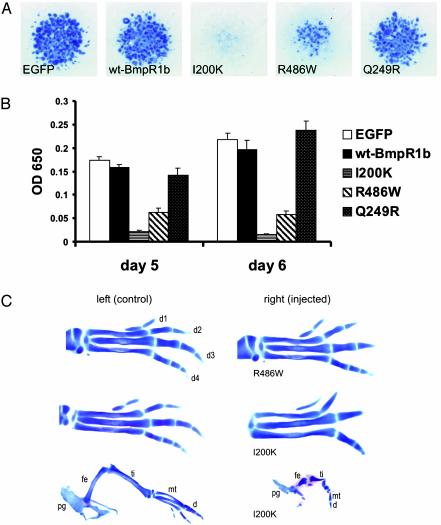Fig. 4.
Retroviral overexpression of BmpR1B mutants in micromass cultures and in chicken embryos. (A) Alcian blue-stained micromass cultures after 5 days of cultivation transfected with control [enhanced GFP (EGFP)] virus, WT Bmpr1b, or the indicated mutant constructs. In comparison with cultures expressing enhanced GFP– or the WT gene, those expressing either the I200K or R486W mutation genes exhibited a strong inhibition of chondrogenesis. (B) The quantification of Alcian blue incorporation into the extracellular matrix of micromass cultures reflecting the production of proteoglycan-rich cartilaginous matrix measured at days 5 and 6 is shown. Both mutations strongly inhibit cartilage formation. Note the stronger effect of the I200K mutation. The Q249R mutation described in the Booroola strain of Mérino sheep was also tested but shows no significant difference to WT BmpR1b. (C) Transfection of mutant chBmpR1b in chicken limbs induces a variable phenotypic severity, presumably due to infection efficacy. Infected limbs (Right) are shown along with the uninfected contralateral control limbs (Left). The milder phenotypes observed for both mutations (Top) display a marked BD with absent middle phalanges (R486W) or missing distal phalanges (1200K). In limbs with a high infection rate, a much stronger phenotype was observed, resulting in extreme shortening of all skeletal elements (I200K, Bottom). pg, pelvic girdle; fe, femur; ti, tibia; mt, metatarsal; d, digit.

